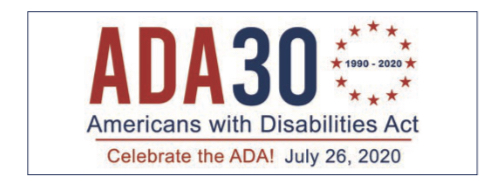
BBI Continues Its Work on Behalf of the Landmark Legislation
July 26, 2020, marked the 30th anniversary of the Americans with Disabilities Act, civil rights legislation that prohibits discrimination against individuals with disabilities in all areas of public life—including jobs, schools, and transportation—and all public and private places that are open to the public.
For the Burton Blatt Institute, the anniversary is a time for celebration and reflection. While the landmark legislation and related legislation (including the Americans with Disabilities Act Amendments Act of 2008) have done much to accommodate and integrate disabled persons—and to change society’s views and attitudes toward disability—barriers to full inclusion still exist.
Helping to oversee BBI’s ADA 30th anniversary commemoration— including at the website adaanniversary.org— University Professor Stephen Kuusisto, Director of Interdisciplinary Programs and Outreach at BBI, discusses the ADA’s profound effect on society, education, and culture, and what the future holds.

Thirty years on, how would you characterize the effectiveness of the ADA?
The ADA has been remarkably successful as a change agent for American culture, which isn’t surprising because one of its goals was to assist the disabled to enter public life. It’s no longer unusual to see wheelchair users, guide dog travelers, the deaf, and autistic folks participating in every area of civic life.
Along with this participation we see changes in the arts and popular culture. In the 1970s no one would have imagined prime time television shows featuring characters with autism. Disability is now better understood as a part of who we are as a nation.
One also could argue that the ADA created a new geographical imagination. That is, the legislation induced needed changes to public spaces; along with that came a host of new features for architecture, design, and cyberspace.
Observers talk about an ADA mindset among a new generation of disabled persons growing up after the legislation passed—can that idea be extended to the rest of the population? It’s no longer acceptable to shrug off disability, although some might still wish to do so. For younger folks who’ve grown up after the adoption of the ADA, there’s an expectation that disability will be properly accommodated and that inclusion is to be expected.
That’s a sea change from my childhood, which took place pre- ADA. People in my generation had to fight to get into the room. I had a professor in graduate school tell me that I shouldn’t be in his class, owing to my blindness. That discrimination might happen today in some places, but I think it’s mostly a thing of the past. Society is more engaging and accepting of disability in general and of the disabled in particular. There’s still much work to be done, but a lot has been accomplished.
You’ve alluded to examples of the positive effects of the ADA for the general population. Can you expand on that idea? Many people are unaware that some of the technologies they use daily are the products of disability design work. For instance, Siri and Alexa come out of work by Ray Kurzweil in the 1970s and 1980s. He invented talking optical character recognition systems for the blind.
The Kurzweil Machine was originally as big as a washing machine, and it had a copying machine glass top. You’d lay a printed book on the plate, and it would scan and read the pages aloud. That technology became the foundation for all kinds of contemporary talking devices. It’s also the case that once Apple decided to make every one of its products accessible for the blind, they found numerous ways to use text-to-speech to benefit every customer.
What improvements to the ADA and the integration of disabled persons into society can we look forward to in the next 30 years?
We desperately need to see new forms of pedagogy based on the understanding that in fact no two persons actually learn in precisely the same way. Work being done now to accommodate neurodiverse students or folks who are blind or deaf will likely lead to better integrated and inclusive forms of teaching and digitization.
If you were made ADA czar for a new presidential administration, what recommendations or actions would you take in your first 100 days?
I would tackle the disability-unemployment problem. Even 30 years after the passage of the ADA, the unemployment rates for the disabled remain terribly high. A figure that’s routinely accepted is that 70% of the disabled who are of working age remain unemployed in the United States. This can be changed with real incentives to small businesses and larger companies to hire the disabled. This solution is feasible, and it would get people off of Social Security disability and into the workforce. The long-term benefits would be remarkable.

How would you characterize BBI’s ADA-related work to those unfamiliar with your mission and projects?
BBI is named for Burton Blatt, a foundational scholar and activist who pioneered the field of disability studies here at Syracuse University. Dr. Blatt helped to revolutionize how we think
about disability and helped us understand that disability is not what it seems.
One way to think about this perspective is that just as we understand people are not defined by gender or race, Burton Blatt showed us that the disabled body and our attitudes toward it are merely societal ideas and have nothing to do with the disability itself. Today, BBI works globally to promote inclusion and opportunity for the disabled by breaking down such barriers.
How is BBI helping to celebrate the 30th anniversary of the ADA?
Even as we speak I am working with the US Department of State to create a virtual poetry reading featuring some of our nation’s leading poets—with and without disabilities—to celebrate the cultural dimensions of disability art and civil rights. BBI is also planning future events that we hope will occur on the University campus once we’re able to convene in person again.
